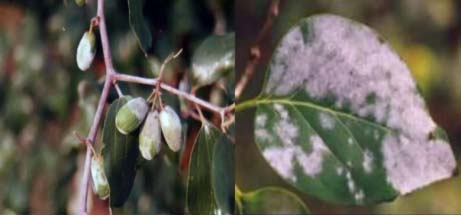What is Powdery Mildew?
Powdery mildew is the most common fungal disease found in Apple Ber. It gets it name due to a grayish powdery mass which is the growth of its mycelia.
- It is a major disease-causing up to 40% loss in production and quality of ber fruits in semi-arid and sub-tropical regions.
Causal Organism – Oidium erysiphoides f. sp. Zizyphi / Microsphaera alphitoides
Symptoms
- The symptoms of the disease are noticed on flowers and newly set fruits.
- The disease may appear earlier if conditions are favourable. The developing young leaves show a whitish powdery mass, which causes them to shrink and defoliate.
- The disease also appears in the form of white powdery spots on the surface of the fruits and later covers the whole fruit surface. The spots turn into light brown to dark brown discolouration. The infected area becomes slightly raised and rough.
- Affected fruits either drop off prematurely or become corky, cracked, misshapen and remain underdeveloped.

Mode of spread –
- The powdery mildew fungus overwinters in dormant buds. When conditions are favourable for growth of the fungus in spring, spores are produced, released, and cause new infections.
- Secondary spread of the disease can occur if spores are produced in these new infections
Management
| Cultural Control | Biological Control | Chemical Control |
| The infected part of the plant should be pruned regularly.Keep the orchard clean by removal of plant debris and infested plant parts.Maintain adequate aeration by proper pruning and training. | Use of bio fungicides like Bacillus subtilis & Trichoderma spp. Can inhibit the growth of the fungus. | Foliar Spray of Carbendazim 50% WP @ 2 gm/litre.Tebuconazole 50%+ Trifloxystrobin 25% WG @0.3 gm/liter.Flusilazole 40% EC @0.1 ml/litre. |
References: –
- https://ppqs.gov.in/sites/default/files/ber.pdf
- https://www.slideshare.net/slideshow/disease-and-insect-pest-of-ber-and-their-management/251441177








